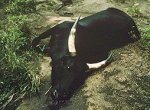Carbon Capture and Sequestration (CCS) is an important aspect of so-called “clean coal” technology. Relatively few demonstration projects exist and already one is reportedly leaking carbon dioxide in levels high enough to kill animals.
Carbon Capture and Sequestration projects typically involve injecting carbon dioxide waste, such as is generated by coal fired power stations, underground. Capturing and compressing CO2 is an energy intensive and expensive process, estimated to increase the fuel needs of a coal-fired power station anywhere between 25%-40%. Add to that the transportation and injection of the carbon dioxide and the costs become astronomical.
Aside from the irony of the technology actually requiring more coal to be mined and burned, many questions remain as to the long term safety of burying massive volumes of compressed carbon dioxide underground.
The concerns are not unwarranted. In the 1980’s a large leakage of naturally sequestered carbon dioxide occurred in Lake Nyos in Nigeria, killing around 1,700 people and many thousands of animals. When carbon dioxide is release in large quantities, it forms a suffocating blanket close to ground level.
While there are no commercial scale CCS projects currently in operation anywhere in the world, some demonstration projects exist.
In Canada, CTV reports that a Saskatchewan farm couple claim carbon dioxide supposedly stored permanently underground by an oil company is leaking, killing animals and contaminating surface water. A consultant has confirmed high concentrations of carbon dioxide in the soil that matches the carbon dioxide being injected.
In Australia, the Queensland government recently withdrew from a clean coal project involving CCS, saying it was not viable at this time on a commercial scale.
The image above depicts a cow suffocated by CO2 at Lake Nyos in the 1986 incident












































